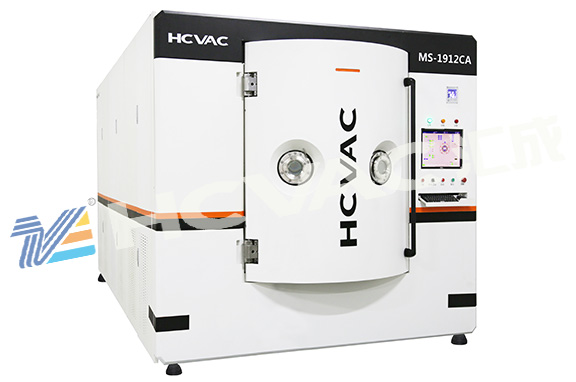Most magnetron sputtering pvd coating machine use magnetron sputtering coating technology. The so-called "sputtering" refers to the phenomenon in which charged particles bombard a solid surface (target), causing solid atoms (or molecules) to be ejected from the surface. Most of the ejected particles are in the atomic state, often called sputter atoms. The charged particles used to bombard the target may be electrons, ions or medium-sized particles. Because ions are easy to accelerate and obtain the required kinetic energy under an electric field, ions are mostly used as bombardment particles. This particle is also called an incident ion. Since the mechanism that directly realizes sputtering is ions, this coating technology is also called ion sputtering coating or deposition.

There are many coating methods for magnetron sputtering pvd coating machine. The more representative methods are:
1. DC diode sputtering. The structure is simple, and a uniform thin film can be produced on a large area substrate. The discharge current changes with changes in pressure and voltage;
2. Three-pole or four-pole sputtering. It can realize low pressure and low voltage sputtering, and can independently control the discharge current and the ion energy of the bombardment target. The target current can be controlled and radio frequency sputtering can also be performed;
3. Magnetron sputtering (or high-speed, low-temperature sputtering). Apply a magnetic field in a direction parallel to the target surface, and use the magnetron principle that the electric field and magnetic field are orthogonal to reduce the bombardment of electrons on the substrate and achieve high-speed and low-temperature sputtering;
4. Sputter towards the target. Two targets are placed facing each other, and a magnetic field is applied in a direction perpendicular to the surface of the target, so that magnetic materials can be sputtered at high speed and low temperature;
5. Radio frequency sputtering. Developed to produce insulating films, such as silicon oxide, alumina, glass films, etc., and can also sputter metal;
6. Reactive sputtering. Compound films of cathode materials can be made, such as titanium nitride, silicon carbide, aluminum nitride, aluminum oxide, etc.;
7. Bias sputtering. During the coating process, light charged particles on the substrate are simultaneously removed, so that the substrate does not contain impure gases;
8. Asymmetric AC sputtering. The target is sputtered during the half cycle with large amplitude, and the substrate is bombarded with ions during the half cycle with small amplitude to remove the adsorbed gas to obtain a high-purity film;
9. Ion beam sputtering. Under high vacuum, ion beam sputtering coating is used, which is a film-forming process in a non-plasma state. Target ground potential is also acceptable;
10. Suction sputtering. By utilizing the gettering effect on sputtered particles, impurity gases are removed, and a thin film with high purity can be obtained.
The above 10 types are the magnetron sputtering coating methods used by
magnetron sputtering pvd coating machine. Customers have relatively high requirements on the adhesion, structure, and morphology of the substrate film. Most of them use vacuum magnetron sputtering coating technology.



